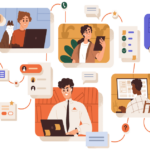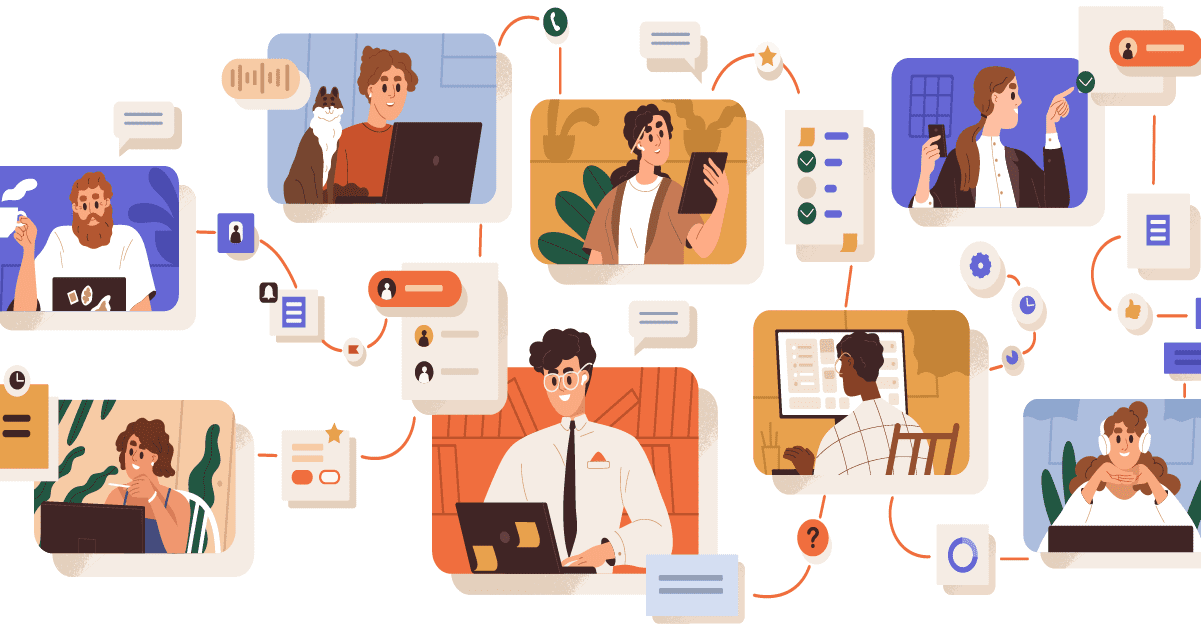- Guest Contributor
- March 22, 2023
With more companies turning to gig workers to meet their staffing needs, there’s been an increase in no-call/no-show incidents. These occur when an employee fails to show up for a scheduled shift without notice or explanation.
Most of us have even been there before. It goes like this: After investing hours of your time sourcing and screening applicants, you land the perfect fit. Your new hire signs all the paperwork, his or her upcoming shifts are scheduled and confirmed, and communication is abundant. Then, out of nowhere, you’re short a person during their assigned shift without any insight into why they failed to show up.
No-call/no-shows are embarrassing for hiring managers, stressful for floor managers, and frustrating for the entire team left to deal with lacking on-site personnel. In today’s hyper-connected world, these incidents can also feel like a slap in the face. After all, what could be so pressing that the employee couldn’t even provide a heads-up with a simple text from their mobile device?
Unfortunately, events like no-call/no-shows and employee ghosting have become prevalent aspects of the gig economy. Why? Gig workers provide a flexible, cost-effective solution to companies with short-term and seasonal employment needs. Companies benefit from low-commitment staffing arrangements—and thus sacrifice employee loyalty for affordability.
If you own a business or you’re in charge of hiring, you’ve probably experienced your fair share of employee no-shows. And if you’re someone who wears many hats, the repercussions can take you away from other important managerial responsibilities. No one likes when candidates bail on their shift, yet no-shows affect industries big and small.
The rise of no-call/no-shows has become a cost of doing business today. But that’s not to say there’s no recourse. Your first reaction may be to reprimand the candidate or the agency you used. But what if you could implement strategies during the recruiting process to minimize the likelihood of no-shows altogether?
In this blog, we’ll explore what no-call/no-shows are, the proactive steps you can take to prevent them, and how to troubleshoot these situations after the fact. Use this as a guide to decrease no-call/no-show emergencies and help ensure that the people you expect to show up actually show up.
Table of Contents
- What does no-call/no-show mean?
- Why do no-call/no-shows happen
- How to create your own policy
- How to handle questions about no-call/no-shows
- Steps you should take to prevent no-shows
- Templates, examples, and write-up samples
- How to depend on your staff
What does a no-call/no-show mean?
Let’s start with the brass tacks: What is a ‘no-call/no-show’? A no-call/no-show describes any scenario where an employee neither shows up for their work shift nor contacts their supervisor to communicate their absence. No-call/no-shows occur across industries and negatively impact everyone involved.
When a restaurant server fails to make it to the dinner service, their colleagues must scramble to wait on additional tables. Meanwhile, patrons experience poor service. Decreased tips, poor reviews, low employee morale, and eroding customer loyalty can all result.
Likewise, when a remote tech employee doesn’t log onto their computer for their first day of work, it’s unnerving to the team. No-call/no-shows are less damaging when the worker isn’t in a front-line or customer-facing role, sure. And the immediate damage may not be as severe. But this still puts employers in a difficult position. Salaried positions often require a more involved vetting process, making it likely that the company had already invested money interviewing, onboarding, and delegating tasks to the new employee.
No-call/no-shows negatively impact employee morale and productivity, as well as the overall functioning of the business. They can result in lost time, money, and resources as employers scramble to find replacements or make up for the lost work. In addition, they create a sense of instability and uncertainty among the remaining staff, who may resent being left in a lurch whenever coworkers fail to show up for work.
It’s also worth noting that no-call/no-shows can happen at any time. Even a loyal and consistent team member might miss a shift. That’s why companies handle unexcused absences differently depending on the scenario.
No-call/no-show policies and other preventative measures
Regardless of the industry, many employers today opt to include a no-call/no-show policy in their new-hire paperwork to mitigate this risk. These policies outline the consequences of failing to show up to a shift without providing notice. For instance, a strict policy might state that any worker who fails to show up without notice will be terminated from their position.
Having a clear no-call/no-show policy in place protects the employer should the situation occur and curbs the likelihood by outlining consequences in advance. These should be included in a worker’s contract or agreement and reviewed as early as possible. In addition to formalizing the policy in writing, you’ll want to encourage employees to contact you immediately if they’re unable to make it to work. Finally, you’ll want to have a plan in place for how to fill the gap left by an absent worker. All of these methods are baked into how Jobble handles no-call/no-shows.
Why do no-call/no-shows happen?
Many have been on the employer side of a no-call/no-show, and many have been on the employee side of it as well. Remind yourself that we’re all human, and it’s not outside the realm of possibility that something unexpected prevented your employee from showing up or communicating. Besides, stewing in anger won’t accomplish anything.
Sure, there’s a long list of no-call/no-show excuses. Family emergencies and personal illnesses are popular go-tos. Why are these such common excuses and reasons for no-call/no-shows? Simple. Both are legitimate causes for missing work without explanation.
Below are some of the reasons why no-call/no-shows occur.
Legitimate emergencies
From severe weather to personal emergencies, legitimate calamities impede people from showing up to work every day. You won’t know the reason behind their absence until you’ve contacted a no-show. So remember: medical issues, mental health struggles, and countless other circumstances can arise without warning.
In these cases, respect and sympathy for your employee’s situation won’t only minimize conflict, it’ll pave the way to loyalty and longevity. It’s always a good idea to give your staff the benefit of the doubt rather than jumping to conclusions.
Changes in plans
Life plans and day-to-day plans are dynamic for gig workers and full-time workers alike. Think about your own schedule and how often it changes. What if you were also balancing multiple jobs with your hours and work locations fluctuating on a daily basis? Even if a candidate was sure that they’d be available when they agreed to the work, it’s possible that it no longer fits with their schedule.
For this reason, proactive and frequent communication is key. No matter what type of job was offered, reach out to confirm the details a couple of days before the start date. This helps minimize a no-call/no-show on the first day of work. You’ll also want to frequently socialize the shift schedule to prevent unexpected absences from tenured employees. Lastly, consider using tools like Jobble to prevent scheduling issues.
Transportation limitations
Without a good transportation network, applicants can have a hard time getting to work. From car troubles to limited public transportation, issues traveling from point A to B often get in the way of employee attendance.
There’s nothing you can do to prevent someone’s car from breaking down—but sending directions that include public transportation routes can significantly reduce any travel frustrations. Likewise, if inclement weather is in the forecast, confirm that everyone on the schedule has a backup plan in place and has allotted the appropriate travel time for increased traffic.
Miscommunication
What’s “no-call/no-show” in Spanish? “No llamar, No presentarse” is a direct translation (but it doesn’t imply the same meaning).
Whether you’re communicating with employees across languages, or across competing mediums (email, text messaging, etc.), miscommunication is one of the biggest obstacles to productivity. Perhaps your employee thought their coworker agreed to pick up a shift, or maybe they misinterpreted the fact that their shift ended early for a holiday and assumed they had the entire day off.
To belabor the point again: communication and transparency are key. Always aim to over communicate at the risk of being annoying rather than under-communicate at the risk of total catastrophe.
Low pay
Sometimes it’s hard to choose a pay that’ll lock down your applicants. And when another opportunity comes knocking that renders your offer chump change, workers will move on without hesitation.
Create an attractive and competitive pay rate that sets your position apart from others in the industry. To ensure attendance, it doesn’t hurt to confirm with your hires that they’re okay with your hourly rate in a follow-up conversation.
Lacking relationships and personalization
It’s your job to keep workers motivated and excited about the job by building a sense of community. Orientations and training sessions are a great way of doing this. Face-to-face encounters build rapport and boost morale.
Consider it from the employee’s side. It’s a lot easier to ghost a faceless supervisor and let down coworkers you hardly know than it is to disappoint teammates you know and respect.
Intentional vs. accidental no-call/no-shows
Do no-call/no-shows happen by accident? Absolutely. Do they also result from intentional (albeit disrespectful) decisions made by employees? Unfortunately, yes.
Your best bet will always be to model the same behavior that you expect from employees. If you frequently dump extra shifts on your staff with little warning or respect for their time, they won’t be inclined to give you ample notice about changes to their schedule.
Earn their respect and communication by embedding it into the culture. This starts from the first time you come into contact with an employee—as early as the first interview.
How to create your own no-call/no-show policy
Creating your own no-call/no-show policy requires grabbing some boilerplate text and tweaking it as you see fit. We’ve provided a policy template below so that you can get started in a snap. But first, here are key items to consider when creating your policy:
- What constitutes a no-call/no-show: If your MIA employee shows up an hour into the shift and is ready to hit the ground running, is that considered late or will it be handled as a no-call/no-show? Be sure to define how much notice is required, what’s the preferred communication method, and at what point ‘late’ becomes ‘absent’ within your policy.
- Consequences: Clearly outline what consequences will result if an employee fails to provide notice for an absence. Whether it’s suspension, termination, or another disciplinary action, negative reinforcement is often an unfortunate necessity.
- How the policy will be communicated: There’s no point in putting a policy in place if workers aren’t aware it exists. Make sure everyone is on the same page about what counts as a no-call/no-show, how notice should be provided before a missed shift, and what the consequences are. Alert staff that was there prior to the new policy and include it in relevant documentation like the employee handbook.
- Consistently enforce the policy: The policy will only be as effective as your own adherence to it. If employees see one teammate consistently breaking the rules without reprimand, they’ll take your policy with a grain of salt.
- Update the policy regularly: Ensure that your policy remains relevant and effective by updating it often. We’ve seen plenty of external forces change the way businesses operate in recent years. For instance, there was that recent global pandemic that revolutionized on-site requirements in every industry. Adapting to the dynamic business landscape has never been so crucial. Keeping your expectations realistic and up-to-date allows you to do just that.
Common policies from large retailers
Amazon
Amazon’s attendance policy works on a points system, and additional points are given based on the severity of an infraction. Employees who provide 16 hours’ notice that they’ll miss a shift aren’t penalized as severely as employees who only give 2 hours’ notice, with those providing no notice whatsoever receiving the highest point deduction. Any worker who receives 6-7 points within a 90-day period will be fired.
Home Depot
Home Depot requires employees to immediately inform their store if they can’t make it to work. This is counted against the sick leave accumulated, but if they have not stored any hours, it’s marked up as an ‘occurrence.’ Multiple occurrences result in disciplinary action and warning, with termination resulting from ongoing infractions.
FedEx
According to QuerySprout, FedEx requires employees to provide two hours of notice via phone prior to being absent or tardy for a scheduled shift. Two unexcused absences (no-call/no-shows) are tolerated, but three can result in termination.
Kohl’s
Kohl’s assigns unplanned absence (UA) hours to new employees that renew each year and increase with tenure. Their staff must stay within that range to avoid repercussions.
Kroger
Kroger’s attendance policy varies depending on union affiliation. At the height of the pandemic, grocery worker shortages prevented Kroger from taking too strict of a stance on no-call/no-shows. As a result, it’s unclear what their current policy is.
Lowe’s
Employees who fail to show up or call in for three scheduled shifts in a row are terminated from Lowe’s. That said, if the employee can produce a doctor’s note outlining a legitimate cause of absence, the missed days will be excused.
Macy’s
Macy’s operates on a point system like Amazon. A missed day with notice results in one point deduction, whereas a missed day without notice chalks up three points. Tardiness can also result in point deductions. Once an employee runs out of points, they are terminated.
Target
Target’s policy varies on a store-by-store and was also handled with more leniency during the pandemic. Either way, no-call/no-shows are considered significantly more serious than absences that were called in.
Walmart
According to NCESC, Walmart also uses a point system to discourage tardiness and absences. Five points can result in termination, and a single no-call/no-show counts as two points.
How to handle questions about no-call/no-shows
As illustrated above, every employer handles no-call/no-shows differently. Here are some of the questions your staff member might ask and how to answer them.
Does a no-call/no-show go on your record?
Documenting no-call/no-shows allows companies to be fair with how they handle these types of infractions. In many cases, recording them internally is a necessary step to preventing repeat occurrences.
How to apologize for no-call/no-show
In cases where a no-call/no-show was without legitimate cause, the best excuse is no excuse. So if an employee fails to make it to work due to their own irresponsibility, their first action should be to apologize to coworkers and supervisors by acknowledging what a bind their absence put everyone else in.
How many no-call/no-shows before termination?
At what point does a no-call/no-show result in unemployment? This should be defined in your policy and proactively communicated. Let your staff know the nuts and bolts, as well as when extenuating circumstances require the situation to be evaluated on a case-by-case basis.
Is no-call/no-show voluntary termination?
For some large employers like Lowe’s, three no-call/no-shows in a row result in voluntary termination. Clarify with your staff if you have a similar structure in place. This gives them all the information they need to play by the rules.
Steps you should take to prevent no-shows
Screen candidates thoroughly
Get a feel for your candidates’ work ethic and set clear expectations from the get-go. Gauge candidate commitment levels and develop interview questions that focus on attendance. Ask questions like: “When someone doesn’t show up for a shift, it causes stress to the rest of the team. Are you committed to showing up for your scheduled shift and always alerting us if an emergency prevents you from working?”
Confirm every shift
As soon as you hire a candidate, reach out and confirm that they’re still available to work on the days you need help. Reiterate the hours and location to make sure that they properly understand the logistics of the position. Follow up with a day-before reminder and continue to make the schedule a focal point of your communication throughout their employment. If an employee hasn’t shown up 10 minutes into their shift, go ahead and call them so that you can start troubleshooting accordingly.
Consider adjusting your hours
If you’re having a hard time finding applicants that can fill your shifts because the hours are either too short or too long, find a happy medium and adjust to calm their frustrations. Gauge employee satisfaction regularly by asking workers what parts of the job they like the most and which parts are a source of frustration.
Set up a standby list
Having a plan B won’t prevent no-shows, but it will allow you to react quickly when chaos erupts. Even with the best of intentions, things can come up and you always want to be prepared. If a candidate tells you that they aren’t going to be available 24 hours before or without any warning at all, you’ll benefit from having a list of people to reach out to.
Templates, examples, and write-up samples
Now that we’ve detailed the best practices, considerations, industry-standard approaches, and philosophical musings on no-call/no-shows, here are templates to use when tackling unexcused absences. Feel free to copy and paste our write-up for no-call/no-shows, termination letter, and policy template below.
No-call/no-show policy template
No-call/no-show policies are often baked into a company’s attendance policy. Here’s a template for language to include within your larger policy. Specifically, it outlines what counts as a no-call/no-show and what disciplinary actions result from them.
Employee Notification Expectations
Punctual and regular attendance is expected of employees at [company name]. Employees are expected to arrive at work on time for all scheduled shifts. Requests for days off should be made at least [time period] in advance and must be confirmed by the employer. In the case of illnesses, accidents, or other emergencies that arise unexpectedly, employees are required to call [designated time frame for notifying about unexpected absence] and notify the supervisor. Notification must take place through [list acceptable notification methods]. Unacceptable notification methods include [list unacceptable notification methods].
Definition of No-Call/No-Show
A no-call/no-show occurs when an employee fails to show up for a scheduled shift without notifying their supervisor of the absence. If [amount of time before tardiness is considered an absence] pass without any communication from the employee about their absence, this is filed as a no-call/no-show and handled accordingly. Each shit that the employee fails to report to or notify a supervisor about is considered a no-call/no-show event.
Disciplinary Action
After [x] no-call/no-show events, the employee will be issued a write-up.
After [y] no-call/no-show events, the employee will be put on probation.
Once [z] no-call/no-shows are recorded, the employee will be terminated.
Job Abandonment
Any employee who fails to report to work for a period of three days or more without notifying his or her supervisor will be considered to have abandoned the job and voluntarily terminated the employment relationship.
No-call/no-show write-up sample
Once you’ve confirmed that an emergency situation didn’t prevent your employee from reporting to work, it’s a good idea to issue a write-up. This disciplinary no-call/no-show write-up sample documents the absence dates, consequences for repeated behavior, and other details about the violation.
Dear [Employee’s name],
Your recent notice for missing a scheduled shift (classified as a no-call/no-show) on [date of infraction] violates [company name’s] attendance policy and negatively affects both your individual performance and your team’s productivity. This is a serious infraction and failure to comply with our policy results in disciplinary action.
This is your [first] warning notice. We expect you to correct your behavior and follow our policy by:
- Requesting time off in advance and awaiting confirmation that the request has been accepted.
- Alerting us as soon as possible when emergencies prevent you from making it to a scheduled shift.
If this behavior continues, we will have to take further disciplinary action, including possible probation and termination.
I’m available to discuss any complications you face that cause your [absence at work.] Please, contact me directly if there’s any way I can help you.
Sincerely,
[Your name]
[Your email signature]
No-call/no-show termination letter
If you’ve exhausted all your resources by putting preventative measures in place, outlining your policy and socializing it to the team, issuing a write-up after the initial occurrence, and communicating the repercussions… and your employee’s behavior still isn’t changing, then termination becomes an unfortunate reality. Here’s a sample letter for ending the work arrangement with a repeat no-call/no-show offender.
Dear [Employee’s name],
I regret to inform you that your employment with [company name] is being terminated, effective (add date). Your termination is the consequence of repeated failure to show up to work or provide notice of your absence (classified as a no-call/no-show). Specifically, you made this infraction on the following dates: [dates].
Please return any company property that is in your possession. A delay or failure in doing so would cause a delay in the issuance of your final paycheck.
If you are entitled to any remaining pay, it will be calculated and paid under [company’s name] policies. Please can contact the HR department with any questions or concerns.
Sincerely,
[Your name]
[Your email signature]
How to depend on your staff
While no-call/no-shows may be a part of business (especially in the gig economy), hiring frustrations don’t need to be. Jobble helps streamline hiring by connecting employers with 5+ million gig workers on a per-job basis. Our all-in-one staffing platform lets you hire and pay for temporary workers when you need them and reduce no-shows with automated overhiring. What’s more, it’s flexible, affordable, and simple to use.
Manage and grow your workforce today by scheduling a demo.
Ready to become a staffing expert?

About the Author: Traci Ruether is a content marketing consultant and writer specializing in SEO for SaaS brands. You can follow her on LinkedIn at linkedin.com/in/traci-ruether or learn more at traci-writes.com.










